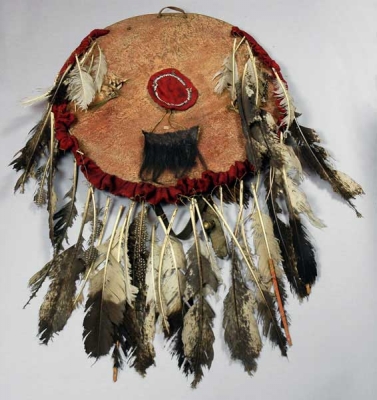Medicine shield (1886.1.821)
 USAMedicine shield from the USA, Americas. Taken in battle in 1854 and collected by Charles Pope by 1866. Transferred to the Museum from the Ashmlolean Museum in 1886.
USAMedicine shield from the USA, Americas. Taken in battle in 1854 and collected by Charles Pope by 1866. Transferred to the Museum from the Ashmlolean Museum in 1886.
This circular hide shield measured 50cm in diameter and is edged with red flannel, with feathers, beads, fur and a piece of human scalp attached. It belonged to the Comanche, once one of the largest North American tribes, who possessed a strong horse-mounted warrior tradition. They inhabited the vast Southern Plains region that now spans New Mexico, Colorado, Kansas, Oklahoma and Texas. This shield is supposed to have been taken from the Comanche by their old adversaries, the Osage, in a battle on the head of the Arkansas River in 1854.
Comanche shields were made from two thicknesses of buffalo hide, thickened over a fire, and densely packed between with feathers, fur or paper. This made them effective at stopping arrows and sometimes even musket balls. Once, a Comanche shield was found that was stuffed with pages from a hefty Anglo-American book about the history of Rome! Comanche shields were highly valued objects, whose various decorations granted it mystical, protective powers; hence the name, 'Medicine Shield'.
Sacred Weapons
Like many other Native American cultures, Comanche tradition understands the eagle to possess spiritual power in relation to warfare. As a result, eagle feathers were attached to shields, worn tied in the hair, and woven into war-bonnets. Comanche shields usually bore four or six feathers. Medicine shields are powerful and sacred objects, which were stored in a secret location up to a kilometre from the warrior's home tipi. Painting the shield was a vital stage, and shield designs had a form of mystical 'copyright' on them. A warrior seeking a design for his shield undertook a shamanic Vision Quest to consult with benevolent spiritual beings, including the sun and moon, spirits of thunder and lightning, and the spirits of bird and mammal species. Due to the content of his Vision, the warrior would produce a design that expressed the powers that aided him. Powerful Medicine Shields offered the warrior supernatural protection and imbued him with the animal qualities of his spirit allies. Shields came with buckskin covers, and their faces were unveiled immediately before battle commenced.
Comanche warriors hung various attachments to their shields, as personal insignia or items of spiritual power. Among other things, part of an enemy scalp is attached to this example. Scalping was an integral part of Comanche warfare, as it was for many of their neighbours. Removal of the scalp destroyed the victim's soul, and prevented the spirit of a defeated enemy from taking revenge on his killer. Comanche warriors considered it better to die trying to preserve the scalp of a fallen comrade, than to survive a battle themselves. They practised the astonishing skill of hanging out of their saddles and picking up a fallen comrade with one hand, pulling him over the shoulders of the horse, at a full gallop. The display of a scalp on this shield shows that the owner was a successful and experienced warrior. The shield also has the rattle of a rattlesnake attached to it. Even if it had killed a human being, the Comanche would only kill a rattlesnake if it had chosen not to rattle before it struck. Rattlesnakes were considered agents of divine will so there is a powerful symbolism in associating this dangerous animal with a weapon. Tufts of bear-hair attached to the shield indicate that the owner was considered a great hunter, as well as a great warrior.





